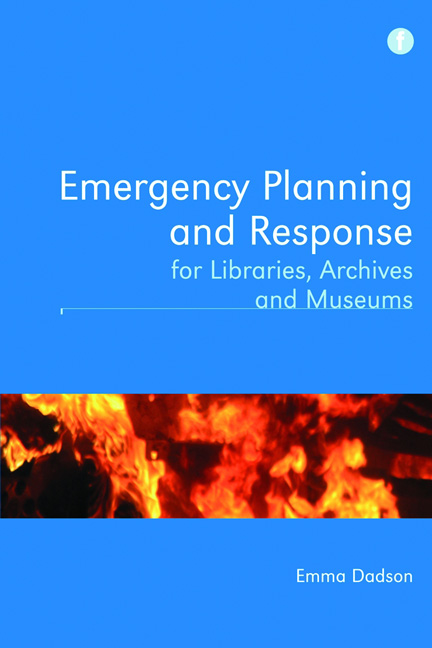Book contents
- Frontmatter
- Contents
- Foreword
- Preface
- Acknowledgements
- 1 Introduction
- 2 Case studies
- 3 Roles and responsibilities
- 4 Incident control
- 5 Planning the recovery operation
- 6 Collections salvage
- 7 Supplementary content
- 8 Dealing with the building
- 9 Business continuity
- 10 Ensuring the plan's efficacy
- 11 Conclusion
- Bibliography and references
- Index
8 - Dealing with the building
Published online by Cambridge University Press: 08 June 2018
- Frontmatter
- Contents
- Foreword
- Preface
- Acknowledgements
- 1 Introduction
- 2 Case studies
- 3 Roles and responsibilities
- 4 Incident control
- 5 Planning the recovery operation
- 6 Collections salvage
- 7 Supplementary content
- 8 Dealing with the building
- 9 Business continuity
- 10 Ensuring the plan's efficacy
- 11 Conclusion
- Bibliography and references
- Index
Summary
This chapter explains some key issues in dealing with damage to buildings after physical damage through water or fire. Restoration of buildings is a specialist area and ideally requires professional input, therefore these notes are intended as a reference tool rather than as content that should be inserted into the plan. The notes for the Building Recovery Manager suggest that airmovers and dehumidifiers should be introduced immediately, and that a specialist contractor should then be appointed to advise on how to use them.
In the aftermath of an incident involving damage to collections, such is the focus on the salvage and recovery operation for these items that often the impact on the room and building is forgotten. This can be a very costly error, however. Even after the smallest leak, failure to consider the impact on the storage environment can lead to longterm problems with humidity, which may ultimately cause mould growth on items due to poor environmental conditions perhaps weeks or months in the future.
Katie Sambrook, Special Collections Librarian, King's College London, described an emergency resulting from an overflowing drain:
Heavy rain over a weekend caused an inadequate drain to overflow and water to enter a lower ground floor corridor and collection store. No collection items were damaged but the water ran under the false floor supporting the mobile shelving units. The response from the estates department was prompt once notified and they arranged thorough drying, cleaning and disinfection of affected areas. Fortunately authorisation of expenditure to contract the mobile shelving company was prompt. They were asked to move the shelving units and lift the false floor so that it could be dried and disinfected where water had been trapped.
Investigation of cause was conducted and steps have been implemented to minimize risk of a similar flood in the future:
• installation of a water detection alarm system
• construction of a concrete ‘dam’ next to drain
• introduction of regular checks of areas during heavy rain.
Incident happened over the weekend but was not detected until Monday morning, despite presence of security staff and porters on site (no system of checking then in place, but one was subsequently introduced).
- Type
- Chapter
- Information
- Publisher: FacetPrint publication year: 2012



